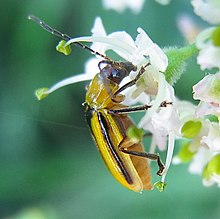
Pesticide resistance describes the decreased susceptibility of a pest population to a pesticide that was previously effective at controlling the pest. Pest species evolve pesticide resistance via natural selection: the most resistant specimens survive and pass on their acquired heritable changes traits to their offspring. If a pest has resistance then that will reduce the pesticide's efficacy – efficacy and resistance are inversely related.
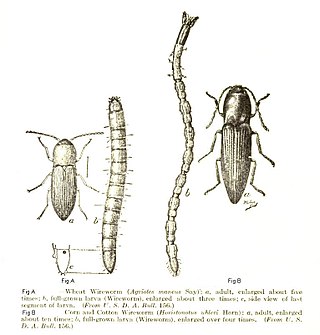
Elateridae or click beetles are a family of beetles. Other names include elaters, snapping beetles, spring beetles or skipjacks. This family was defined by William Elford Leach (1790–1836) in 1815. They are a cosmopolitan beetle family characterized by the unusual click mechanism they possess. There are a few other families of Elateroidea in which a few members have the same mechanism, but most elaterid subfamilies can click. A spine on the prosternum can be snapped into a corresponding notch on the mesosternum, producing a violent "click" that can bounce the beetle into the air. Clicking is mainly used to avoid predation, although it is also useful when the beetle is on its back and needs to right itself. There are about 9300 known species worldwide, and 965 valid species in North America.
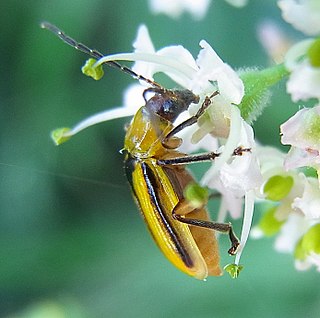
The Western corn rootworm, Diabrotica virgifera virgifera, is one of the most devastating corn rootworm species in North America, especially in the midwestern corn-growing areas such as Iowa. A related species, the Northern corn rootworm, D. barberi, co-inhabits in much of the range and is fairly similar in biology.
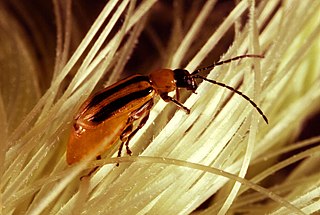
Diabrotica is a large, widespread genus of beetles in the family Chrysomelidae. Members of this genus include several destructive agricultural pest species, sometimes referred to as cucumber beetles or corn rootworms.

Allomyrina dichotoma, also known as Japanese rhinoceros beetle, Japanese horned beetle, or kabutomushi, is a species of rhinoceros beetle.

Diabrotica undecimpunctata, the spotted cucumber beetle or southern corn rootworm, is a species of cucumber beetle that is native to North America. The species can be a major agricultural pest insect in North America. Spotted cucumber beetles cause damage to crops in the larval and adult stages of their life cycle. Larvae feed on the roots of the emerging plants, which causes the most damage since the young plants are more vulnerable. In the adult stage the beetles cause damage by eating the flowers, leaves, stems, and fruits of the plant The beetles can also spread diseases such as bacterial wilt and mosaic virus.
Talitropsis is a genus of cave wētā in the family Rhaphidophoridae, endemic to New Zealand, and containing six described species. Two Talitropsis species are found only on the Chatham Islands.
Proxiphocentron is a genus of caddisflies from South-east Asia.

DIMBOA (2,4-dihydroxy-7-methoxy-1,4-benzoxazin-3-one) is a naturally occurring hydroxamic acid, a benzoxazinoid. DIMBOA is a powerful antibiotic present in maize, wheat, rye, and related grasses,

Cylindrocaulus patalis is a beetle of the family Passalidae. It is found in Japan. The larval period is only a month, likely due to parental care. The adults feed on wood.
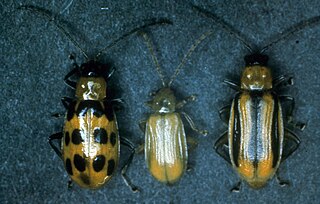
Cucumber beetle is a common name given to members of two genera of beetles, Diabrotica and Acalymma, both in the family Chrysomelidae. The adults can be found on cucurbits such as cucumbers and a variety of other plants. Many are notorious pests of agricultural crops. The larvae of several cucumber beetles are known as corn rootworms.

Eysarcoris is a genus of shield bugs belonging to the family Pentatomidae, subfamily Pentatominae, and typical of the tribe Eysarcorini.

Diabrotica balteata is a species of cucumber beetle in the family Chrysomelidae known commonly as the banded cucumber beetle. It occurs in the Americas, where its distribution extends from the United States to Colombia and Venezuela in South America. It is also present in Cuba. It is a pest of a variety of agricultural crops.
Cardiosyne is an extinct genus of beetles from the Triassic of Argentina. It was originally tentatively classified in Elateridae, but in 2020 it was transferred to Coleoptera incertae sedis.
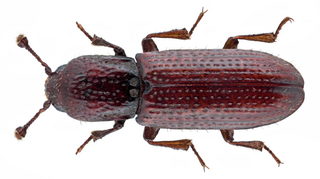
Teredidae is a family of beetles in the superfamily Coccinelloidea, formerly included within the family Bothrideridae. There are around 160 species in 10 genera, found worldwide except South America. Teredids are generally found under bark, in the galleries of wood-boring beetles, or in leaf litter. They are thought to be fungivores. The oldest records of the family are Delteredolaemus from mid-Cretaceous aged Burmese amber from Myanmar and a species of Teredolaemus from Eocene aged Baltic amber.
Diabrotica longicornis is a species of skeletonizing leaf beetle in the family Chrysomelidae. It is found in Central America and North America.

Diabrotica barberi, the northern corn rootworm, is a species of skeletonizing leaf beetle in the family Chrysomelidae. It is found in North America. Adults feed on corn, and, when corn is unavailable, goldenrod pollen.
Anthonomus testaceosquamosus is a species of true weevil in the beetle family Curculionidae. It is found in North America. Its common name is the hibiscus bud weevil, as females lay their eggs in hibiscus flower buds.
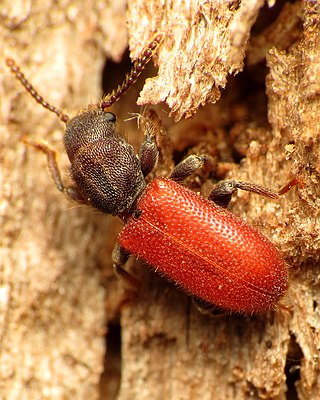
Thanerocleridae is a family of beetles belonging to the superfamily Cleroidea. It was formerly considered a subfamily of Cleridae, but was recently elevated to the rank of family. The family has 36 living species in 10 genera, which are found globally, mostly in low-latitude tropical regions, though the genus Zenodosus is found in temperate North America. Thaneroclerid species are likely all predatory both in adult and larval stages. They target small fungus and wood associated beetles, and are generally found in places where such beetles are likely to be found, typically tree associated habitats such as under bark, though some species occur in other locations such as termite nests.

Erasmoneura vulnerata is a species of leafhopper native to North America. The species was found to be in Europe in 2004 where it causes significant economic damage to grapevine yards. E. vulnerata is commonly found on wild and cultivated grapes from both continents. Its Latin name translates to "wounded Erasmoneura" from its original description.
